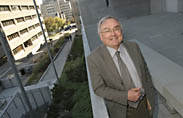Planning for the future
Years from now, when today's McGill students return to the university for distant reunions, what will they find? The campuses will probably be as familiar as they are to those alumni who are returning for this homecoming weekend: no doubt the lower campus's green fields and heritage buildings will still be there. Still, those sharp-eyed alumni 50 years from now will also be able to identify much that is different. And many of the changes — and the elements that remain, too — will grow out the new Task Force on the McGill University Physical Master Plan.

Dean of Engineering John Gruzleski
Owen Egan
"We're planning for the long term, with a time frame of 25 to 50 years, so while we have to consider practicalities, we also have something of a blue-sky mandate to suggest how the physical aspect of the university could develop," says engineering dean John Gruzleski, chair of the task force, which was formed this summer and will report to Morty Yalovsky, vice-principal (administration and finance), in the spring of 2006. The 13-member task force includes representatives from across the university community: academic faculties, students and support staff, as well as members chosen for their critical knowledge.
"McGill is an important part of the community and it is essential that the development of the university be done according to our guiding principles," says Gruzleski. "These principles include commitment to community, responsible stewardship, maintenance of green space, the integrity of the mountain and the preservation of McGill's heritage architectural assets."
The Task Force will consult widely within the McGill and greater community on a broad range of issues including community life, physical development plans, and other issues.
The mandate of the task force also includes:
- Examination of the teaching, research and support facilities and infrastructure that will be required to support academic and research excellence and development, including emerging disciplines and multidisciplinary programs, in the longer term.
- Enhancement of the unique presence and role of McGill within the community and of its partnerships with the community.
- Preservation and enhancement of the architectural character and quality of McGill campuses.
- Enhancement of McGill's high-quality, accessible, pleasant, safe and secure environment.
- Definition of sustainable development approaches.
- Optimization of the year round use of the campuses for both academic and community purposes.
- Broad consultation with partners and community members and organizations.
Gruzleski says that McGill's downtown campus, which is land-locked, faces challenges that are very different from those at Macdonald campus, which occupies 1,600 acres on the western end of the Island of Montreal. A sub-group led by Jacques Hurtubise, acting vice-principal (research), is focusing on various options for the future of the Macdonald campus. Another sub-group, led by Dr. Abraham Fuks, Dean of Medicine, will examine various teaching activities that may be part of the Glen Yards site, which will house the McGill University Health Centre (MUHC).
As for the current downtown campus, says Gruzleski, "We want to ensure that it is user friendly as well as environmentally friendly, and that it integrates well with our neighbours on all sides." While the task force is only at the start of its mandate, he is able to toss out a few possible ideas for improvement. "The idea of turning McTavish Street into a pedestrian mall is a very enticing. Currently, that street is dangerous: we have students crossing it and yet it's a main thoroughfare," he says. "We also have to look at parking issues: if you think about a campus that is safe and pleasant, I'm not sure you want a bunch of cars all over it. One alternative might be underground parking."
Finding solutions will involve seeking local input from members of the university and looking at how others have dealt with similar challenges.
"We don't want to reinvent the wheel," stresses Gruzleski. "We would rather learn some best practices from other urban universities."
On the Macdonald Campus, the concerns are quite different. "We have space for new construction: it is a very open campus with a core of heritage buildings, and it can be developed in a very interesting and attractive way," Gruzleski says. But the possibility of moving courses in some programs to the Macdonald Campus is hindered by transportation. "The West Island is the fastest growing part of Montreal, and road connections are getting more clogged," he says. "This problem will just get worse, too." That said, he notes, there may well be some downtown facilities that could be moved to Macdonald — although just what remains to be seen.
"McGill has always been a central part of the community and will continue to play an important role in our quality of life," Gruzleski says. "There are many options and opportunities and we want to ensure that McGill's development continues to contribute positively to the community in which we live."
Gruzleski stresses that the task force would like members from across the university to make written submissions on any issue related to the physical plan. Submissions can be mailed to John Gruzleski through the Faculty of Engineering or emailed to john.gruzleski@mcgill.ca.
